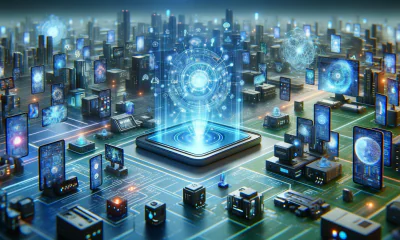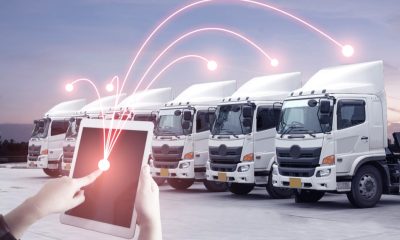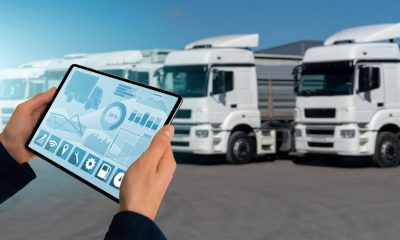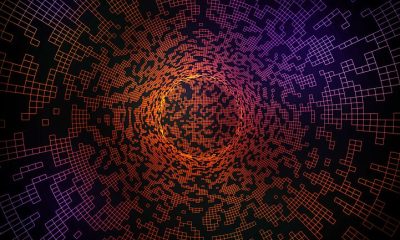Artificial Intelligence
Edge Computing vs. Cloud Computing: Major Differences

In 2022, the global cloud computing market was expected to reach $661 billion. Another technology that has garnered enterprise attention in the last few years is edge computing – a distant cousin of cloud computing.
The adoption of cloud services by enterprises is also expected to grow, with 83% of enterprise workloads expected to be in the cloud, 58% in public cloud environments, and 25% in private clouds.
The recent rise in demand for data and analytics has increased the importance of cloud computing. It has enabled enterprise organizations to process vast amounts of data in real time, making it easier to make data-informed decisions.
With the continued advancement of cloud technology, it is becoming widely adopted across industries. In fact, cloud adoption among enterprise organizations is over 94%. A Gartner survey suggests that 84% of organizations have at least one application or a portion of their computing infrastructure in the cloud.
In this article, we’ll understand edge and cloud computing in detail. We’ll talk about their pros and cons and list their major differences. Let’s begin.
What is Edge Computing?
Edge computing is a type of distributed computing architecture where data processing and analysis occur at the network's edge, i.e., closer to the data source rather than in a central data centre.
Edge devices are computing devices, such as routers, sensors, and IoT devices, that are designed to accomplish specific tasks, such as remote monitoring of assets or equipment and autonomous vehicles. They serve as the first point of entry into the network.
What is Cloud Computing?
Cloud computing delivers computing resources, including servers, storage, databases, networking, software, and analytics, as services over the internet.
Cloud computing services can be delivered in a variety of models, including public, private, and hybrid, each with its own unique benefits and trade-offs (not covered in the scope of this article).
Cloud-enabled businesses don’t have to manage the underlying hardware infrastructure of their applications, which allows them to focus on their core business, resulting in faster innovation and growth.
Prominent cloud providers include Google Cloud, Amazon Web Services, and Microsoft Azure. They manage and maintain application infrastructure and ensure security, reliability, and performance at scale.
Pros of Edge Computing
New and creative approaches to managing data flow have emerged as a result of the exponential growth in the amount of data produced by commercial activities. Edge computing is one such technique. Let’s highlight some advantages of edge computing below:
- Low Latency: Edge computing processes data locally, reducing the need for data transmission over long distances, which results in lower latency and faster response times.
- Improved Reliability: By processing data closer to the source, edge computing can continue operating even without an internet connection, making it a more reliable option for critical applications.
- Improved Security: Edge computing can improve security by reducing the amount of sensitive data transmitted over a network and by processing data locally, reducing the risk of data breaches.
Cons of Edge Computing
Enterprise organizations are increasingly adopting edge computing architecture to streamline their application workflows, But it has some limitations as well. Let’s highlight some edge computing cons below:
- Complexity: Implementing, maintaining, and upgrading edge computing infrastructure can be complex and requires specialized skills and expertise.
- Limited Scalability: Edge computing resources are limited by the physical infrastructure at the edge, making it challenging to scale resources to meet growing demands.
- Interoperability: Different edge devices and systems may not be compatible, making it difficult to integrate multiple systems into a single, cohesive edge computing solution.
Pros of Cloud Computing
Nowadays, almost every company has switched its services to cloud computing to unlock its growth potential. Let’s highlight some major advantages of cloud computing below:
- Cost Savings: Cloud computing eliminates the need for significant capital expenditures on hardware, software, and IT infrastructure. The cloud providers offer these services on an on-demand or pay-as-you-go basis.
- Accessibility: Cloud computing services can be accessed from anywhere with an internet connection, making it possible for remote workers to access the same resources and applications.
- Flexibility: Cloud computing offers a wide range of services, allowing users to choose the specific services that meet their needs and allowing for easy integration with existing systems.
Cons of Cloud Computing
By reducing expenses, increasing accessibility, and enhancing flexibility, cloud computing has benefitted enterprises. Despite these advantages, it has several limitations as well. Let’s highlight some major cons of using cloud computing below:
- Security Concerns: Storing sensitive data in the cloud can raise security concerns. Cloud computing providers may not provide the same level of security as on-premises solutions.
- Dependence on Internet Connectivity: Access to cloud computing services requires a stable and reliable internet connection, and outages can disrupt access to these services.
- Compliance Issues: Certain industries have specific regulatory requirements for data storage and processing, and cloud computing providers may not always meet these requirements.
Edge Computing vs. Cloud Computing–What’s the Difference?
While edge and cloud provide computing resources to end-users, some key differences make them suitable for different applications. Let’s highlight some of these differences below:
| Edge Computing | Cloud Computing |
| Edge computing processes data at or close to the edge of the network. | Cloud Computing processes data in a central data centre or a remote server farm. |
| Edge computing has low latency, as data is processed close to the source. | Cloud computing can have higher latency as data is transmitted to a remote location for processing. |
| Edge computing requires decentralized control and management closer to the edge devices. | Cloud computing provides centralized control and management of resources. |
| Edge computing is well-suited for IoT and other time-sensitive applications where low latency and real-time processing are critical. | Cloud computing is well-suited for applications that require large amounts of computing resources, such as big data and machine learning. |
Cloud/Edge Computing–What the Future Holds?
Edge and cloud computing are two technology solutions that address different computing needs. Edge computing focuses on bringing computing closer to the network's edge, where data is generated and processed. In contrast, cloud computing is a centralized model that provides remote access to shared computing resources over the internet.
The choice between edge and cloud computing depends on the application's specific requirements, such as the need for low latency, data security, and network connectivity. The most effective solution often involves a combination of both technologies, like a hybrid cloud architecture.
Organizations can leverage a hybrid architecture where edge can be used for deploying individual application instances, and the cloud can be used for managing centralized application updates and monitoring.
The combination of cloud computing and edge computing provides a more efficient and scalable solution for data processing and storage. The cloud handles large amounts of data and processing power while edge computing handles local data processing. It reduces the amount of data that needs to be sent to the cloud.
Practically, there are endless possibilities for using both technologies together. Check out these 7 Best Cloud Certifications if you want to advance your cloud knowledge! Stay up to date with modern technology!














